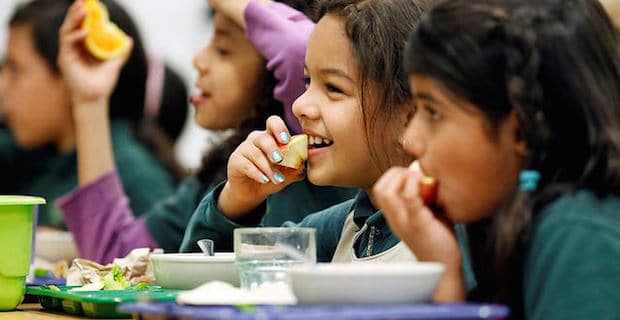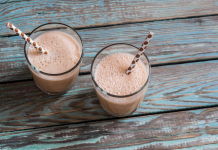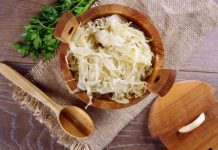
Nutritious meals are important for all of us, especially our children. What children eat does make a difference, especially in school, reports a study published in the Journal of School Health, a journal published on behalf of the American School Health Association.
To establish a link between diet and academic performance, University of Alberta researchers evaluated the lifestyle and performance of some 5,000 children. Students who ate an adequate amount of fruit, vegetables, protein and fiber, with less calorie intake from fat, did better on their literacy tests than those eating foods high in salt and saturated fat, common in processed food.
While a healthy diet is generally assumed to be important for good school performance, there has actually been little research on this topic. To date, most research on diet and school performance has focused on the importance of eating breakfast, as well as the ill effects of hunger and malnutrition.
Read more about how omega-3s help cognitive development in children
So what can you do to ensure your children are performing to their optimal potential at school? Start them off with a nutritious breakfast and pack them a health promoting lunch consisting of whole grains, fresh fruit and vegetables and protein to ensure they obtain the daily recommended intake of vitamins and minerals. Children need the right foods to keep them going through the day so they can carry out their tasks of learning, playing and growing. Healthy food will give them enough energy to last the school day and will also provide the building blocks for a healthy adult.
The best kind of energy is the kind that is consistent, avoiding the highs and lows provided by sugar. To get this kind of good stuff in the supermarket, you will need to arm yourself against the charms of many food manufacturers and the irresistible appeal of clever packaging. “Low Fat” does not mean low sugar, and “natural” does not always denote wholesome ingredients. Two simple rules to remember when grocery shopping are: the fewer ingredients on the label the better; and if you can’t pronounce it, you probably shouldn’t be eating it. You can never go wrong if you choose “whole foods”. Whole foods are foods that are unprocessed and unrefined, or processed and refined as little as possible before being consumed. They typically do not contain added ingredients, such as sugar, salt, or additional fat.
As parents, we face the usual lunchbox dilemma: we want to pack a nutritious healthy lunch for our kids, but we are typically feeling rushed for time every morning. Lunches do not have to be complicated- with a little planning, simple nutritious meals can be put together in minutes.
Time Saving Tips
- Keep raw, marinated chicken, beef or salmon bite size cubes (or strips) in the freezer packed in individual portion-sized baggies. The night before, pull out a bag and defrost in the refrigerator overnight. Broil for 5-7 minutes in the morning. Cooked meat or fish can be easily tossed into a salad, wrap or pita bread. Or, try mixing it with pasta or brown rice. Another easy option is to thread meat or fish onto wooden skewers (use lollipop sticks for the little ones) with chopped vegetables.
- Reserve a few slices of your weekend roasts for weekday sandwiches. Freeze cooked thinly sliced turkey, beef, chicken or pork roast in single portion-sized containers. Defrost meat in the refrigerator overnight for easy sandwich preparation in the morning.
- Double up. Always have lunch on the top of your mind when you are preparing big pot dinners such as spaghetti sauce, chilli or soup. Double your recipe and freeze individual-sized portions that can be easily heated and tossed into a thermos for a hot homemade lunch.
- Store large quantities of cooked brown rice or pasta (kamut, spelt or whole wheat pasta are healthier options) in the refrigerator. Cooked rice or pasta can last up to 3 days in the fridge. Mix with sauce or toss into soups and you’ll have a hot lunch in minutes. For a cold pasta or rice salad, reserve chopped raw vegetables from last night’s dinner and toss with prepared cooked pasta or rice and dress with a little olive oil, lemon juice, garlic (optional) salt and pepper.
- Beans are an excellent nutrient dense food choice full of protein, fiber and complex carbohydrates that will provide energy and keep your children’s blood sugar level stable for hours. Boil batches of dried beans on the weekend and keep individual-sized portions in the refrigerator. Cooked beans can be stored for 3-4 days. Beans can also be frozen in individual containers and defrosted in the refrigerator overnight. Toss beans into salads, soups, pita bread or mash with a little olive oil, garlic and lemon juice for an instant “hummus” that can be spread onto wraps. If you are using canned beans, opt for organic beans with no salt.
Read more about the healthiest beans, grains and legumes
- Keep washed sliced vegetables in the fridge. Choose a selection of vegetables that your children like such as peppers, carrots, celery, cherry tomatoes, broccoli, lettuce, cucumbers. Prepared vegetables can be quickly added to sandwiches and salads or packed into individual snack containers.
- Try quick-cooking whole grains. Whole grains are complex carbohydrates that can be easily prepared in a thermos. Measure ¼ cup grain and rinse well under cold running water. Add ¾ cup boiling water. Let stand 10 minutes or overnight in the refrigerator. In the morning, open a thermos and add in some chopped vegetables and beans dressed with olive oil, salt, garlic, lemon juice and herbs for a quick satisfying meal. Quinoa, a protein-rich ancient grain, can also be prepared in a thermos and mixed with either vegetables or a little cinnamon and maple syrup.
- Stock your pantry with single portion easy-to-grab snack options such as whole wheat crackers, rice cakes, pumpkin or sunflower seeds (great over a mixed salad), dried cranberries, apricots, dates or apples and raisins. Keep single portion-sized containers of fresh berries, melons, pineapple, grapes and cheese in the refrigerator for quick add-ins to salads or as healthy snack options.
Image: U.S. Department of Agriculture
“Healthy Diet Means Better School Performance”, Reuters.com.










